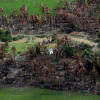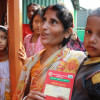Human Development Index: Bangladesh moves up a notch

Bangladesh climbed up a spot to 135 among 189 countries in the 2019 human development index, according to a report by the United Nations Development Programme (UNDP).
It is, however, ranked lower than Sri Lanka, India and Bhutan.
Last year, Bangladesh was ranked 136.
The steady progress was due to development, which had seen a reduction in poverty, along with gains in life expectancy, education, and access to health care.
Bangladesh’s HDI value for 2018 is 0.614 -- which put the country in the medium human development category.
Between 1990 and 2018, Bangladesh’s HDI value increased from 0.388 to 0.614, a 58.3 percent increase.
Between 1990 and 2018, Bangladesh’s life expectancy at birth increased by 14.1 years, mean years of schooling increased by 3.2 years and expected years of schooling increased by 5.6 years. Bangladesh’s GNI per capita increased by about 198.7 percent between the same years.
“We have to address the challenges of inequalities. We have to be very strategic to address them. Why inequality could not be reduced should be addressed,” Ahsan H Mansur, executive director of the Policy Research Institute of Bangladesh, told The Daily Star yesterday.
He also said inequality should be reduced to reap the benefits of development.
The HDI measures the average achievement in three basic dimensions of human development -- life expectancy, education and per capita income.
Norway, Switzerland, Ireland held the top three positions in that order. Germany placed fourth along with Hong Kong, and Australia was ranked fifth.
Sri Lanka (71) and China (85) are higher up the rank scale, while India (130), Bhutan (134), Myanmar (145), Nepal (147), Pakistan (152) and Afghanistan (170) were lower on the list.
As per the HDI, no other region had experienced such rapid human development progress. The report said South Asia was the fastest growing region in human development progress witnessing a 46% growth between 1990-2018, followed by East Asia and the Pacific at 43%.
Bangladesh’s HDI value is 0.614 but it is below the average of 0.634 for countries in the medium human development group and below the average of 0.642 for countries in South Asia.
But when it comes to inequality, the situation is grim. As inequality in a country increases, the loss in human development also increases.
When the value is discounted for inequality, the HDI of Bangladesh falls to 0.465, a loss of 24.3 percent due to inequality.
In the last 28 years, the average annual HDI growth rate of Bangladesh is 1.65. But the growth rate has slowed down compared to 1990-2000 when it was 1.95 to 2010-2018 when it stood at 1.40.
The Gender Development Index measures gender inequalities in the achievement of three basic dimensions of human development -- health (measured by female and male life expectancy at birth), education (measured by female and male expected years of schooling for children and mean years for adults aged 25 years and older) and command over economic resources.
The GDI is calculated for 166 countries. The 2018 female HDI value for Bangladesh is 0.575 in contrast with 0.642 for males, resulting in a GDI value of 0.895.
When comes to the Gender Inequality Index (GII), Bangladesh’s value is 0.536, ranking 129 out of 162 countries in the 2018 index.
In the GII, India is at 122, Sri Lanka at 86, Bhutan at 99 and Myanmar at 106.
In Bangladesh, 20.3 percent of the parliamentary seats are held by women, and 45.3 percent of adult women have reached at least a secondary level of education compared to 49.2 percent of their male counterparts. In comparison, Nepal and Pakistan are ranked at 115 and 136 respectively in the GII.
Former World Bank Economist Zahid Hussain said, “The improvement in the HDI ranking, even though just by a step, is good news. At the same time, the large difference between HDI and the inequality-adjusted HDI is a concern. This reflects not only income inequality but also inequality in the distribution of life expectancy and expected years of schooling.”
He said the distribution of health and education indicators is expected to be more inclusive than the distribution of income. “When that is not the case, the concern is that it would lead to a perpetuation of inequality in society. The problem may be deeper when the quality dimension is taken into consideration.”

 For all latest news, follow The Daily Star's Google News channel.
For all latest news, follow The Daily Star's Google News channel. 








Comments